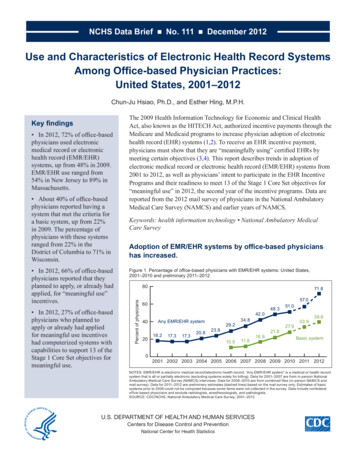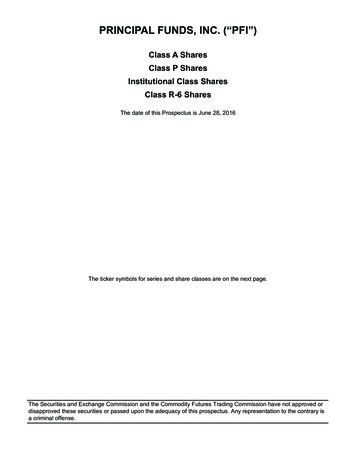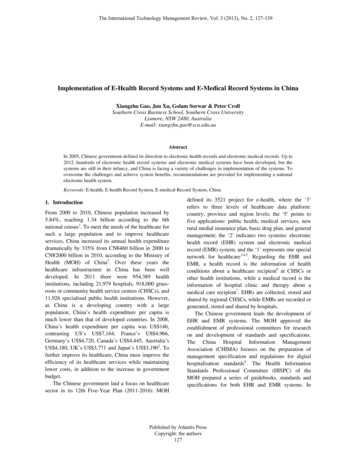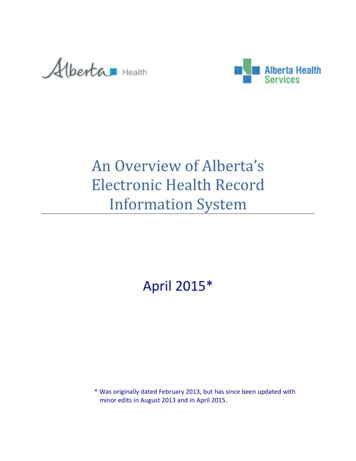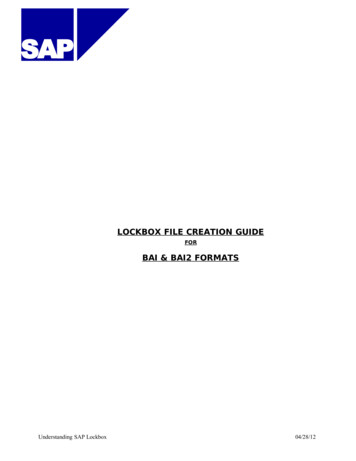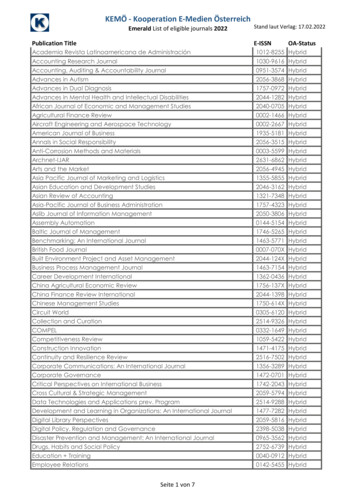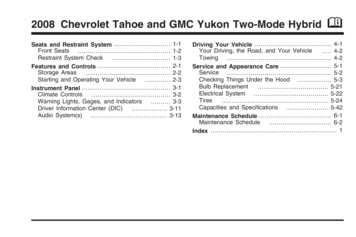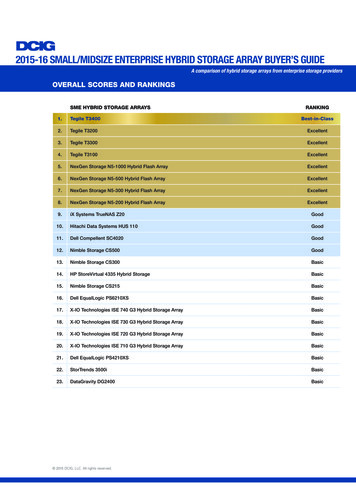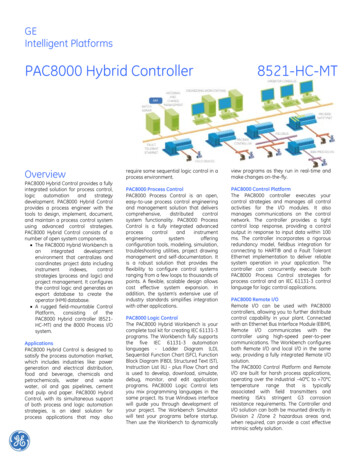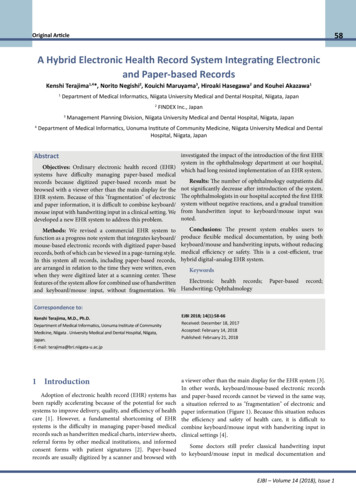
Transcription
58Original ArticleA Hybrid Electronic Health Record System Integrating Electronicand Paper-based RecordsKenshi Terajima1,4*, Norito Negishi2, Kouichi Maruyama3, Hiroaki Hasegawa2 and Kouhei Akazawa11Department of Medical Informatics, Niigata University Medical and Dental Hospital, Niigata, Japan234FINDEX Inc., JapanManagement Planning Division, Niigata University Medical and Dental Hospital, Niigata, JapanDepartment of Medical Informatics, Uonuma Institute of Community Medicine, Niigata University Medical and DentalHospital, Niigata, JapanAbstractinvestigated the impact of the introduction of the first EHRsystem in the ophthalmology department at our hospital,Objectives: Ordinary electronic health record (EHR)which had long resisted implementation of an EHR system.systems have difficulty managing paper-based medicalResults: The number of ophthalmology outpatients didrecords because digitized paper-based records must bebrowsed with a viewer other than the main display for the not significantly decrease after introduction of the system.EHR system. Because of this "fragmentation" of electronic The ophthalmologists in our hospital accepted the first EHRand paper information, it is difficult to combine keyboard/ system without negative reactions, and a gradual transitionmouse input with handwriting input in a clinical setting. We from handwritten input to keyboard/mouse input wasnoted.developed a new EHR system to address this problem.Methods: We revised a commercial EHR system tofunction as a progress note system that integrates keyboard/mouse-based electronic records with digitized paper-basedrecords, both of which can be viewed in a page-turning style.In this system all records, including paper-based records,are arranged in relation to the time they were written, evenwhen they were digitized later at a scanning center. Thesefeatures of the system allow for combined use of handwrittenand keyboard/mouse input, without fragmentation. WeConclusions: The present system enables users toproduce flexible medical documentation, by using bothkeyboard/mouse and handwriting inputs, without reducingmedical efficiency or safety. This is a cost-efficient, truehybrid digital–analog EHR system.KeywordsElectronic health records;Handwriting; OphthalmologyPaper-basedrecord;Correspondence to:Kenshi Terajima, M.D., Ph.D.Department of Medical Informatics, Uonuma Institute of CommunityMedicine, Niigata . University Medical and Dental Hospital, Niigata,Japan.E-mail: terajima@bri.niigata-u.ac.jp1 IntroductionEJBI 2018; 14(1):58-66Received: December 18, 2017Accepted: February 14, 2018Published: February 21, 2018a viewer other than the main display for the EHR system [3].In other words, keyboard/mouse-based electronic recordsand paper-based records cannot be viewed in the same way,a situation referred to as "fragmentation" of electronic andpaper information (Figure 1). Because this situation reducesthe efficiency and safety of health care, it is difficult tocombine keyboard/mouse input with handwriting input inclinical settings [4].Adoption of electronic health record (EHR) systems hasbeen rapidly accelerating because of the potential for suchsystems to improve delivery, quality, and efficiency of healthcare [1]. However, a fundamental shortcoming of EHRsystems is the difficulty in managing paper-based medicalrecords such as handwritten medical charts, interview sheets,referral forms by other medical institutions, and informedSome doctors still prefer classical handwriting inputconsent forms with patient signatures [2]. Paper-basedto keyboard/mouse input in medical documentation andrecords are usually digitized by a scanner and browsed withEJBI – Volume 14 (2018), Issue 1
59Terajima K et al.- : A Hybrid Digital–Analog EHR System.are reluctant to use an EHR system. As a method of producingnarrative progress notes, handwritten input has definiteadvantages over keyboard/mouse input. Keyboard input isslower than handwriting [5, 6]. In addition, keyboard/mouseinput records are inherently more restrictive as comparedwith handwritten sketches or diagrams on paper; therefore,keyboard/mouse input progress notes often have fewer graphicrepresentations [5, 6, 7, 8]. Electronic records are more likely toinclude copied and repetitive notes [5, 9]. Some reports indicatethat constant use of a keyboard and a mouse results in less eye-toeye contact between doctors and patients [4, 10, 11]. Therefore,some physicians consent to the adoption of an EHR system onlyif it permits handwriting on paper.C-Note (FINDEX Inc., Tokyo, Japan) is a progress note systemdeveloped to respond to such doctors’ requests, in which varioustypes of medical records can be viewed in a page-turning style[12]. On the pages we can type text, draw illustrations, importdata and images from external testing equipment, and makeannotations on an image by using a mouse or a pen-tablet deviceas if we are writing on paper. Although this system offers variousmethods for inputting medical documentation with a paper-likeinterface, fragmentation of electronic and paper informationremains a problem (Figure 2). A simple solution to this problem isimmediate scanning of paper-based records, followed by manualpasting of the digitized images onto a progress note page duringthe patient’s care. This is an unrealistic solution in the busy settingof outpatient care because timely manual manipulation of recordsby doctors and clinical clerks is not always possible. Additionally,in large hospitals, paper-based records are often collected anddigitized at a scanning center at least several hours, or possiblya day, after the records are created. In such cases, keyboard/mouse-based electronic records and digitized paper-basedrecords are sometimes not arranged in the order they werewritten, which can result in miscommunication of patientinformation among medical staff.2 ObjectivesTo address the problems described above, we developeda new EHR system by revising C-Note. The new systemintegrates keyboard/mouse-based electronic records withdigitized paper-based records, which can both be viewedin page-turning style. All records, including paper-basedrecords, are arranged in relation to the time they were written,even when they were later digitized at a scanning center.Finally, the system allows for combined use of handwrittenand keyboard/mouse input, without fragmentation ofelectronic and paper information. To verify the effectivenessof the system, we investigated the impact of introducing thefirst EHR system to the ophthalmology department at ourhospital.3 Methods3.1 Revision of the C-Note SystemIn our hospital, MegaOakHR (NEC Corp., Tokyo, Japan)Figure 1: Example of "fragmentation" of electronic and paper information.When using an ordinary EHR system, keyboard/mouse-based electronic records are browsed in the main system display (A). However, aseparate display is needed in order to view digitized paper-based records (B).EJBI – Volume 14 (2018), Issue 1
60Terajima K et al.- : A Hybrid Digital–Analog EHR System.Figure 2: Original progress note system.C-Note (FINDEX Inc.) is a progress note system in which medical records can be created and then browsed in a page-turning style (A).However, the original version requires a separate display to view digitized paper-based records (B).is used as the main EHR system, including a computerizedprovider order-entry system in all departments [13]. Just beforewriting a paper-based record, the user must print a page with aQR code for the patient, which is generated by the main system.The documents written by the user are later picked up, taken to ascanning center, and then digitized on the same day or the nextmorning. The QR code contains patient information, the name anddepartment of the user, the time of printing (approximately equalto the time of writing), and document type (eg, progress note,results of laboratory tests, certificates). Use of QR codes ensuresthat data from digitized paper-based records are registered to thedatabase of all scanned documents in our hospital.We modified the C-Note system so that all data from adigitized paper-based record are also automatically registeredin the system database. Each paper-based record corresponds toone page of the system display. Every time the system databaseis updated (including modifications or deletions of alreadyregistered data), the registered data are rearranged in the order ofwriting, and the double-page view of the system is reconstructed.Therefore, keyboard/mouse-based electronic records and paperbased records are arranged in the order they were written andcan be browsed chronologically in a page-turning style (Figure3). To ensure that records remain arranged in the order they wereoriginally created, already registered paper-based records cannotbe edited, e.g., by adding annotations.3.2 Adoption of the First Ophthalmic EHR in OurHospitalEJBI – Volume 14 (2018), Issue 1Adoption of an EHR system in an ophthalmologydepartment is one of the most demanding challenges in medicalrecord management, because of the unique characteristicsof ophthalmic outpatient care, which include the need formany intradepartmental examinations, the necessity ofdocumentation that emphasizes graphical representationof examination findings, unique outpatient workflows, andhigh clinical volumes [7, 14, 15, 16]. An ophthalmic medicalrecord may contain various data types, such as texts, drawings,photographs, images, graphs, waves, and schematic diagrams.Additionally, the time for writing such records is limitedbecause, as compared with other departments, more patientsare evaluated and the durations of evaluations are shorter.Therefore, the ophthalmology department in our hospital hadlong declined EHR implementation, although several EHRsystems specially designed for ophthalmic medical recordkeeping had been proposed [17, 18]. However, we repeatedlyexplained the unprecedented features of the revised C-Notesystem to the department, which finally agreed to introducethe system—the first ophthalmic EHR system in our hospital.To examine how the system was used, we calculatedthe ratio of the numbers of paper-based to keyboard/mouse-based records. All medical records produced by 28ophthalmologists during the 8 months after the system wasintroduced were categorized as keyboard/mouse-based orpaper-based records. Then, the numbers of paper-based andkeyboard/mouse-based records were counted. The countratios of keyboard/mouse-based to paper-based records(keyboard/paper) were monitored during these 8 months. We
61Terajima K et al.- : A Hybrid Digital–Analog EHR System.Figure 3: The revised progress note system integrates electronic and paper-based medical records.When a paper-based record with a QR code is later digitized at a scanning center, the digitized data are also automatically registered tothe system database as data produced at the time of writing. The double-page view is reconstructed every time the system database isupdated. Therefore, keyboard/mouse-based electronic records and digitized paper-based records are arranged in the system in the orderthey were written.also counted the numbers of ophthalmic outpatients seen during period, which suggests a gradual transition from handwritingthe periods 6 months before and 6 months after implementing input to keyboard/mouse input. However, the count ratiovaried widely by doctor (Figure 7). Some doctors mostly usedthe system.keyboard/mouse input from the beginning (Drs. A and B inFigure 7; a transient decrease in the keyboard/paper ratio for4 Resultsthe two doctors in June was due to a temporary increase inBefore implementing the system, the department used only their request for digitizing documents of new outpatientshandwritten paper-based medical records, including more than referred by other medical institutions), while other doctors20 types of ophthalmic charts, interview records, and informed predominantly used handwritten input (Drs. F and Gconsent forms. When the system was introduced, we converted in Figure 7) throughout the observation period. Despitethese paper-based documents to templates with QR codes stored differences in uptake among physicians, our results show thatin the main EHR system. Representative templates are shown in the ophthalmologists accepted the new EHR system withoutFigure 4. In the system, both keyboard/mouse-based electronic negative reactions, which resulted in a gradual transitionrecords and digitized paper-based records can be browsed in the from handwritten input to keyboard/mouse input.same page-turning style (Figure 5).Figure 8 shows the number of ophthalmic outpatients seenTherefore, a doctor sometimes used these paper-based per day during the 6 months before and after introductiontemplates for handwritten input and other times produced of the system. Although there was an almost 10% decreaserecords with a keyboard/mouse input. Figures 6 and 7 shows in the number of outpatients during the 1–2 months afterthe actual proportions of the usage of these two input methods introducing the system, the number returned to the usualduring the 8 months after system implementation. As shown in level at 3 months after the system was introduced. The averageFigure 6, the count ratio of keyboard/mouse-based to paper- numbers of ophthalmic outpatients per day 6 months beforebased records increased from 1.58 to 2.02 during the 8-month and after implementing the revised system were 122 and 114,EJBI – Volume 14 (2018), Issue 1
62Terajima K et al.- : A Hybrid Digital–Analog EHR System.Figure 4: Representative templates (with QR codes) used in our hospital for paper-based records.When the revised progress note system was introduced, we registered to the system more than 20 types of handwritten paper-basedtemplates with QR codes for ophthalmic charts, interview records, and informed consent forms. The three representative templates shownare an interview record for a new patient (A), a record of an ophthalmic examination (B), and an informed consent document (C).Figure 5: Representative double-page views from the revised progress note system.In this system, both keyboard/mouse-based electronic records and digitized paper-based records can be browsed in a page-turningstyle. The examples from the revised progress note system are a handwritten record of a surgical procedure and an electronic record(A) and a paper-based referral form from another hospital and an electronic record (B).EJBI – Volume 14 (2018), Issue 1
63Terajima K et al.- : A Hybrid Digital–Analog EHR System.Figure 6: The numbers of keyboard/mouse-based (keyboard) and paper-based (paper) records and their count ratio (keyboard/paper).The keyboard/paper ratio was calculated by using data collected from 28 ophthalmologists during the 8-month period after the systemwas implemented. The ratio increased from 1.58 to 2.02 during the 8-month observation period, which suggests a gradual transitionfrom handwritten to keyboard/mouse input.Figure 7: Count ratios of keyboard/mouse-based to paper-based medical records (keyboard/paper) for eight representative doctors.Keyboard/paper ratio varied widely among the physicians. Some doctors used mostly keyboard/mouse input from the beginning(Drs. A and B), while others predominantly used handwritten input (Drs. F and G) throughout the observation period.EJBI – Volume 14 (2018), Issue 1
64Terajima K et al.- : A Hybrid Digital–Analog EHR System.Figure 8: Number of ophthalmic outpatients per day 6 months before and after introduction of our system.Although there was an almost 10% decrease in the number of outpatients during the 1–2 months after introducing the system, thenumber had increased to normal volume at 3 months after system introduction.respectively. These results indicate that there was a minimal andThe most important advantage of our system is thetransient decrease in the number of outpatients seen per unit of coexistence of electronic and paper-based records. Thetime after implementing the system.system offers complete browsing compatibility for the twotypes of records, which are arranged in the order they were5 Discussionwritten rather than by the time of registration. Therefore,The present results show that the first ophthalmic EHR in this system, classical handwriting in paper is acceptedimplementation in our hospital was successful. The decrease as an equivalent input method to keyboard/mouse input,in clinical volume was minimal and transient; thus, the clinical and there is no communication gap between electronic andoutflow in the ophthalmology department was hardly affected paper information. We believe that this is the best solutionby EHR implementation. That contrasts strikingly with for doctors reluctant to use an EHR system. Even usersprevious studies reporting the opposite effect [19, 20]. The who are unfamiliar with the system, e.g., part-time andophthalmologists accepted the new EHR system, and the system temporary employees, can utilize the system by mainlyutilization rate increased in relation to their satisfaction with the using handwriting input from the first day. The transitionsystem. Nevertheless, most ophthalmologists still have concerns from handwritten to keyboard/mouse input can then occurregarding the potential adverse effects on productivity and gradually, in accordance with users' computer literacy andefficiency in ophthalmology practice [18, 19, 21]. Furthermore, understanding of the system. Users can take advantage of thea recent survey found that ophthalmologists’ rate of satisfaction respective benefits of handwritten and keyboard input.with their EHR has decreased [17]. We believe that the success inSimilar systems or devices that aim for coexistence ofour hospital is strong evidence of the effectiveness of our revisedelectronic and paper-based records have important practicalEHR system.EJBI – Volume 14 (2018), Issue 1
65Terajima K et al.- : A Hybrid Digital–Analog EHR System.limitations. First, electronic document management systems(EDMSs) are software programs that manage the creation,storage, and control of documents electronically and can integratescanned documents [22, 23]. However, unlike an EHR system, anEDMS is only used for reference and is not suitable for creatingprogress notes. Second, to our knowledge, only one other EHRsystem (MegaOak-NEOCIS, NEC Corp., Tokyo, Japan [24])developed for large Japanese hospitals is based on concepts similarto those guiding the development of our system. However, theinitial cost of the MegaOak-NEOCIS is at least five times that ofour system. Furthermore, our system allows for easy handling ofmedical records from ophthalmology, otorhinolaryngology, andgynecology departments, without a supplementary system. Third,in contrast to digital pens, digital writing boards, and tablets orsheets of exclusive paper optimized for scanning, our system doesnot require additional devices or supplies, the ongoing costs ofwhich are usually much higher than expected, especially for alarge hospital such as ours. Therefore, we think our system is themost feasible choice in a general hospital.have analyzed the results of the research and K. Akazawahas approved the system introduction and supervised theresearch. All authors have given approval of the final versionto be published.References[1] Yoshida Y, Imai T, Ohe K. The trends in EMR and CPOEadoption in Japan under the national strategy. Int J MedInform. 2013; 82: 1004-1011.[2] Fenz S, Heurix J, Neubauer T. Recognition and privacypreservation of paper-based health records. Stud HealthTechnol Inform. 2012; 180: 751-755.[3] Laerum H, Karlsen TH, Faxvaag A. Effects of scanningand eliminating paper-based medical records on hospitalphysicians' clinical work practice. J Am Med InformAssoc. 2003; 10: 588-595.[4] Saleem JJ, Russ AL, Justice CF, Hagg H, Ebright PR,Woodbridge PA. Exploring the persistence of paper withthe electronic health record. Int J Med Inform. 2009; 78:As discussed above, in the Introduction, similar results can618-628.be achieved by clinical clerks who scan paper by hand and insertit into the appropriate place of an EHR. However, this method[5] Chan P, Thyparampil PJ, Chiang MF. Accuracy andwill likely limit flexibility regarding when and where doctorsspeed of electronic health record versus paper-basedwrite records. Furthermore, it requires many additional workersophthalmic documentation strategies. Am J Ophthalmol.in a large hospital, where multiple doctors use the EHR system2013; 156: 165-72 e2.simultaneously. A future controlled study that compares theoriginal system with on-site processing and our revised system [6] Chiang MF, Read-Brown S, Tu DC, Choi D, SandersDS, Hwang TS. Evaluation of electronic health recordwith posteriori automatic registration would help confirm theimplementation in ophthalmology at an academicbenefits of the latter. We hope this limitation will be addressedmedical center (an American Ophthalmological Societysoon.thesis). Trans Am Ophthalmol Soc. 2013; 111: 70-92.8 Conclusion[7] Chiang MF, Boland MV, Brewer A, Epley KD, HortonMB, Lim MC. Special requirements for electronic healthThe present system enables users to produce flexible medicalrecord systems in ophthalmology. Ophthalmology. 2011;records with keyboard/mouse and handwriting input methods,118: 1681-1687.without fragmentation of electronic and paper information. Thissystem is a cost-efficient, true hybrid digital–analog EHR system. [8] Lim MC, Patel RP, Lee VS, Weeks PD, Barber MK, Watnik9 AcknowledgementMR. The long-term financial and clinical impact of anelectronic health record on an academic ophthalmologypractice. J Ophthalmol. 2015; 329819.We thank Toru Hasegawa, Yasuhisa Wakatsuki, TakuoGoto, and Kozue Saito for their dedicated support during the [9] Hartzband P, Groopman J. Off the record--avoiding theintroduction of the system.pitfalls of going electronic. N Engl J Med. 2008; 358:1656-1658.10 Conflict of InterestK Terajima recieved lecture fees from FINDEX Inc.11 Author Contribution[10] Linder JA, Schnipper JL, Tsurikova R, Melnikas AJ, VolkLA, Middleton B. Barriers to electronic health record useduring patient visits. AMIA Annu Symp Proc. 2006; 499503.[11] Shachak A, Reis S. The impact of electronic medicalrecords on patient-doctor communication duringK. Terajima has contributed to the conception and designconsultation: a narrative literature review. J Eval Clinof research and drafted the article, N. Negishi and H. HasegawaPract. 2009; 15: 641-649.have developed the system, K. Maruyama and H. HasegawaEJBI – Volume 14 (2018), Issue 1
66[12] http://findex.co.jp/en/pdf/cnote en.pdfTerajima K et al.- : A Hybrid Digital–Analog EHR System.on documentation time, surgical volume, and staffing.JAMA Ophthalmol. 2014; 132: 586-592.[13] Namikawa H, Miyakawa R, Sato Y, Takashima K. ElectronicMedical Record System "MegaOakHR". Nec Tech J. 2008; 3: [19] Lam JG, Lee BS, Chen PP. The effect of electronic health89-93.records adoption on patient visit volume at an academicophthalmology department. BMC Health Serv Res. 2016;[14] Chiang MF, Boland MV, Margolis JW, Lum F, Abramoff16:7.MD, Hildebrand PL. Adoption and perceptions of electronichealth record systems by ophthalmologists: an American [20] Redd TK, Read-Brown S, Choi D, Yackel TR, TuAcademy of Ophthalmology survey. Ophthalmology. 2008;DC, Chiang MF. Electronic health record impact on115: 1591-1597; quiz 7 e1-5.productivity and efficiency in an academic pediatricophthalmology practice. J AAPOS. 2014; 18: 584-589.[15] Matsuo T, Gochi A, Hirakawa T, Ito T, Kohno Y. Outpatientsflow management and ophthalmic electronic medical records [21] Read-Brown S, Hribar MR, Reznick LG, Lombardisystem in university hospital using Yahgee Document View. JLH, Parikh M, Chamberlain WD. Time RequirementsMed Syst. 2010; 34: 883-889.for Electronic Health Record Use in an AcademicOphthalmology Center. JAMA ophthalmol. 2017; 135:[16] Park JSY, Sharma RA, Poulis B, Noble J. Barriers to electronic1250-1257.medical record implementation: a comparison betweenophthalmology and other surgical specialties in Canada. Can [22] Kohn D. Electronic document management systems: anJ Ophthalmol. 2017; 52: 503-507.overview. Topics in health information management.2002; 23: 1-6.[17] Boland MV, Chiang MF, Lim MC, Wedemeyer L, Epley KD,McCannel CA. Adoption of electronic health records and [23] Schmidt RA, Simmons K, Grimm EE, Middlebrookspreparations for demonstrating meaningful use: an AmericanM, Changchien R. Integration of scanned documentAcademy of Ophthalmology survey. Ophthalmology. 2013;management with the anatomic pathology laboratory120:1702-1710.information system: analysis of benefits Am J Clin Pathol.2006; 126: 678-683.[18] Sanders DS, Read-Brown S, Tu DC, Lambert WE, ChoiD, Almario BM. Impact of an electronic health record [24] ing room management system in ophthalmologyEJBI – Volume 14 (2018), Issue 1
EJBI olume 14 (2018), Issue 1 Original Article 58 A Hybrid Electronic Health Record System Integrating Electronic and Paper-based Records Kenshi Terajima1,4*, Norito Negishi2, Kouichi Maruyama3, Hiroaki Hasegawa2 and Kouhei Akazawa1 1 Department of Medical Informatics, Niigata University Medical and Dental Hospital, Niigata, Japan 2 FINDEX Inc., Japan 3 Management Planning Division, Niigata .

